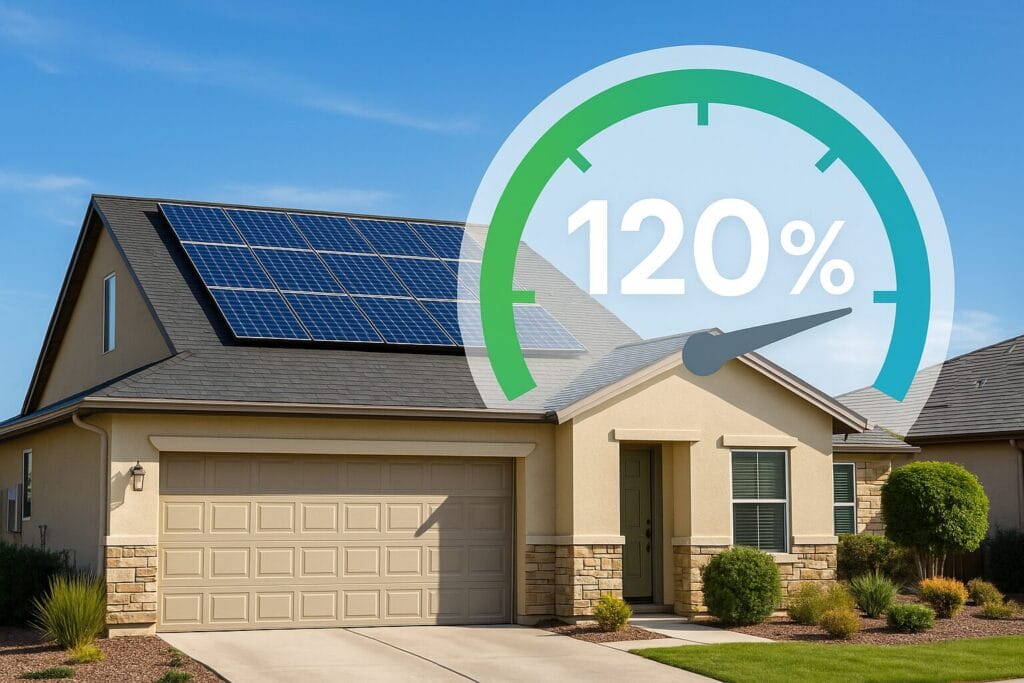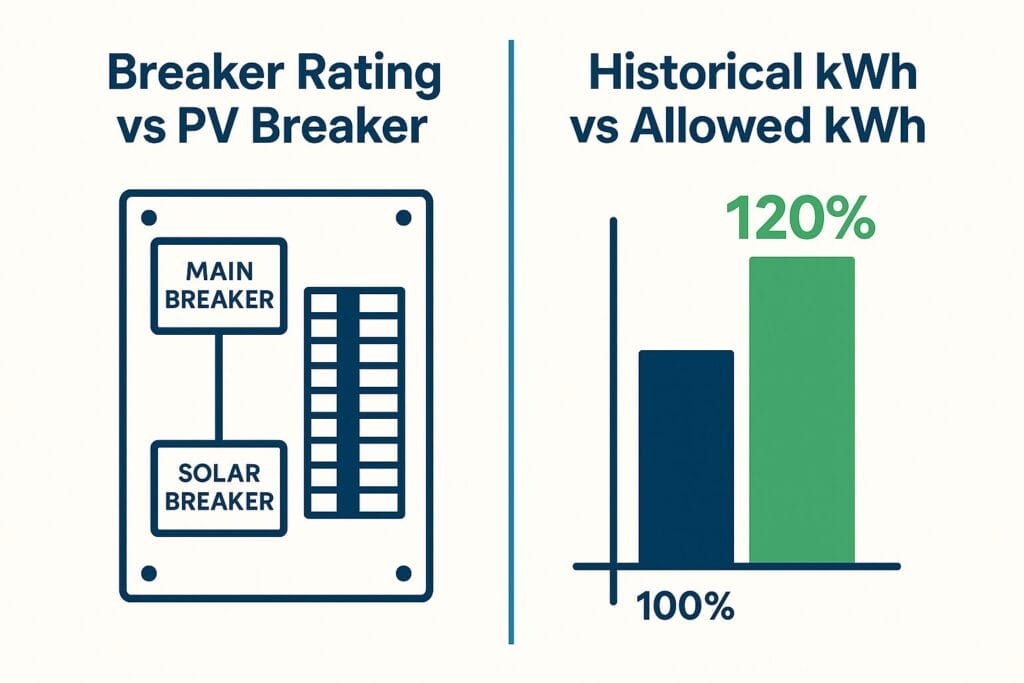
TL;DR – There are actually two “120 % rules” in solar.
- A utility sizing cap that limits how much PV you can connect relative to your past or expected electricity use.
- The NEC 120 % busbar rule that limits how big the back‑fed solar breaker can be inside your main service panel.
Understanding both is critical to designing a system that will pass inspection and deliver the financial return you expect.
1. Quick Primer: Two Different 120 % Rules
| Rule | What It Governs | Simple Formula | Typical Outcome |
|---|---|---|---|
| Net‑metering sizing cap | The maximum annual energy your PV system may produce relative to 12‑month utility data | Allowed kWh = Last‑year kWh × 1.20 | Caps array size (e.g., 9 MWh × 1.2 → 7.7 kW‑DC) |
| NEC 705.12(D)(2) busbar rule | The combined amperage of the utility main breaker + PV back‑feed breaker | Main A + PV A ≤ Busbar A × 1.2 | Often limits PV breaker to 30–40 A on a 200 A panel |
2. Where the 120 % Rule Came From
- Safety first: Early PV codes worried that a fully producing array plus a fully loaded house could overheat the panel busbar, so the National Electrical Code (NEC) introduced the 120 % factor to add a buffer. (mayfield.energy)
- Billing fairness: Utilities adopted parallel “offset” caps (usually 100–120 %) so homeowners could not oversize arrays just to be paid retail rates for excess power.
- Policy evolution: As batteries, EVs and heat pumps push loads higher, many states have relaxed the cap—or scrapped it altogether.

3. State‑by‑State Snapshot (2025)
| State | Current Sizing Cap | Effective Date | Notes |
| Colorado | 200 % of expected average annual consumption | June 21 2021 (SB 21‑261) | Doubled cap to anticipate EV/heat‑pump growth |
| California | 150 % under NEM 3.0 | April 2023 | Higher cap but lower export credit; batteries strongly advised |
| Minnesota | 120 % of production for systems > 40 kW | 2015 rule; reaffirmed 2024 | Cap applies mostly to C&I & community solar |
| Arizona | 125 % of total connected load (residential); up to 150 % of peak demand (APS C&I) | Ongoing | Net‑billing, no traditional net‑metering |
| No explicit cap (e.g., TX, FL) | Sized only by utility interconnection studies | — | Good for very large roofs but may face grid‑impact fees |
Tip: Caps change fast. Check your utility’s tariff before signing an EPC contract.
4. How to Calculate Your 120 % Limit
- Pull the last 12 months of kWh from your utility portal or bills.
- Add the kWh (or download the CSV) to find the annual total.
- Multiply by 1.2 to get the allowable annual PV production.
- Divide by your site’s specific production factor (kWh per kW‑DC) to estimate array size.
Example
• Annual use: 9,000 kWh
• Allowed production: 9,000 × 1.2 = 10,800 kWh
• Southern California production factor: ~1,400 kWh/kW‑DC
• Max array: 10,800 ÷ 1,400 ≈ 7.7 kW‑DC
You can grab your own production factor using the PVWatts tool or by asking our team for a Quick Quote. For more context on household loads, see How many kWh per day is normal?
5. When You’ll Want More Than 120 %
- Electric vehicles: A single EV can add 3,000–4,500 kWh/yr.
- Heat‑pump HVAC / water heating: Often doubles electricity use in gas‑to‑electric conversions.
- Accessory dwelling units (ADUs): California’s Title 24 counts ADU energy under the main meter—plan ahead.
- Battery‑ready designs: Oversizing the array today improves round‑trip efficiency when you add storage later.
Work‑arounds if your state sticks to 120 %:
- Future‑load affidavit: Some utilities allow documented load growth projections (EV purchase agreement, heat‑pump permit).
- Community solar or off‑site solar garden: Allowed in CO & MN.
- Line‑side tap + main‑panel upgrade: Bypasses the busbar rule altogether (see next section).
6. The NEC 120 % Busbar Rule in Plain English
Think of your service panel busbar like a two‑lane bridge:
- Lane 1: Utility power flows down through the main breaker (e.g., 200 A).
- Lane 2: PV power flows up through the solar breaker (often 30–60 A).
The NEC says the sum of those lanes must not exceed 120 % of the bridge’s rating. For a common 200 A busbar:
200 A × 1.2 = 240 A ⇒ Solar breaker ≤ 40 A
Three Ways Around the Busbar Limit
| Option | What It Does | Typical Cost |
| Derate the main breaker to 175 A | Creates room for a 60 A PV breaker; doesn’t touch busbar | $250–$500 |
| Line‑side tap | Connects PV on the utility side of the main breaker; NEC 2023 Article 705.11 clarifies methods | $600–$1,200 |
| Upgrade to 225 A or 320 A panel | Future‑proofs for EV charging & batteries | $2,500–$5,000 |
7. California Focus—NEM 3.0 After One Year
- Higher sizing window (150 %) means oversized roofs are finally feasible, but…
- Export credits average just 4–8 ¢/kWh, so excess generation is worth less than self‑consumption. Batteries shift that excess to evening peaks, dropping payback for PV+storage to 9–11 years on typical homes.
- Smart‑inverter & rapid‑shutdown rules add minor hardware costs but no size penalty.
- Proposals to re‑open NEM 3.0 in 2026 could tweak the 150 % figure—design sooner rather than later.
8. Frequently Asked Questions
Q: Does adding a battery raise my 120 % cap?
A: Usually no. The cap is based on array size or expected generation, not storage. But batteries help use excess on‑site, reducing concerns about oversizing.
Q: Does the busbar rule apply off‑grid?
A: No. If you’re disconnected from the utility, Article 705 (interconnection) doesn’t apply. You’ll follow Article 690 instead.
Q: Will the NEC rise 120 %?
A: A proposal to increase it to 125 % failed in the 2023 code cycle. The 2026 cycle may revisit it, but inspectors will enforce today’s 120 % language until your state adopts newer code.
9. Bottom Line & Next Steps
- The “120 % solar rule” could limit your system for billing or wiring reasons—sometimes both.
- States like Colorado and California now allow 150–200 % sizing, anticipating electrified homes.
- Even if your utility still caps at 120 %, smart design (derating, line‑side taps, batteries) can unlock more capacity.
